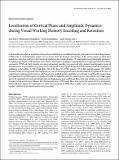| dc.contributor.author | Palva, Satu | |
| dc.contributor.author | Kulashekhar, Shrikanth | |
| dc.contributor.author | Hamalainen, Matti S. | |
| dc.contributor.author | Palva, J. Matias | |
| dc.date.accessioned | 2011-10-12T15:18:38Z | |
| dc.date.available | 2011-10-12T15:18:38Z | |
| dc.date.issued | 2011-03 | |
| dc.date.submitted | 2011-01 | |
| dc.identifier.issn | 0270-6474 | |
| dc.identifier.issn | 1529-2401 | |
| dc.identifier.uri | http://hdl.handle.net/1721.1/66220 | |
| dc.description.abstract | Several studies show that the amplitudes of human brain oscillations are modulated during the performance of visual working memory (VWM) tasks in a load-dependent manner. Less is known about the dynamics and identities of the cortical regions in which these modulations take place, and hence their functional significance has remained unclear. We used magnetoencephalography and electroencephalography together with minimum norm estimate-based source modeling to study the dynamics of ongoing brain activity during a parametric VWM task. Early stimulus processing and memory encoding were associated with a memory load-dependent spread of neuronal activity from occipital to temporal, parietal, and frontal cortical regions. During the VWM retention period, the amplitudes of oscillations in theta/alpha- (5–9 Hz), high-alpha- (10–14 Hz), beta- (15–30 Hz), gamma- (30–50 Hz), and high-gamma- (50–150 Hz) frequency bands were suppressed below baseline levels, and yet, in frontoparietal regions, load dependently strengthened. However, in occipital and occipitotemporal structures, only beta, gamma, and high-gamma amplitudes were robustly strengthened by memory load. Individual behavioral VWM capacity was predicted by both the magnitude of the N1 evoked response component in early visual regions and by the amplitudes of frontoparietal high-alpha and high-gamma band oscillations. Thus, both early stimulus processing and late retention period activities may influence the behavioral outcome in VWM tasks. These data support the notion that beta- and gamma-band oscillations support the maintenance of object representations in VWM whereas alpha-, beta-, and gamma-band oscillations together contribute to attentional and executive processing. | en_US |
| dc.description.sponsorship | Academy of Finland | en_US |
| dc.description.sponsorship | Helsinki University | en_US |
| dc.description.sponsorship | National Center for Research Resources (U.S.) (Grant P41 RR14075) | en_US |
| dc.description.sponsorship | National Institutes of Health (U.S.) | en_US |
| dc.description.sponsorship | National Institute of Biomedical Imaging and Bioengineering (U.S.) (Grant 1R01EB009048) | en_US |
| dc.description.sponsorship | National Institute of Biomedical Imaging and Bioengineering (U.S.) (Grant 1R01 EB006385) | en_US |
| dc.language.iso | en_US | |
| dc.publisher | Society for Neuroscience | en_US |
| dc.relation.isversionof | http://dx.doi.org/10.1523/jneurosci.5592-10.2011 | en_US |
| dc.rights | Article is made available in accordance with the publisher's policy and may be subject to US copyright law. Please refer to the publisher's site for terms of use. | en_US |
| dc.source | SFN | en_US |
| dc.title | Localization of Cortical Phase and Amplitude Dynamics during Visual Working Memory Encoding and Retention | en_US |
| dc.type | Article | en_US |
| dc.identifier.citation | Palva, S. et al. “Localization of Cortical Phase and Amplitude Dynamics during Visual Working Memory Encoding and Retention.” Journal of Neuroscience 31 (2011): 5013-5025. | en_US |
| dc.contributor.department | Harvard University--MIT Division of Health Sciences and Technology | en_US |
| dc.contributor.approver | Hamalainen, Matti S. | |
| dc.contributor.mitauthor | Hamalainen, Matti S. | |
| dc.relation.journal | Journal of Neuroscience | en_US |
| dc.eprint.version | Final published version | en_US |
| dc.type.uri | http://purl.org/eprint/type/JournalArticle | en_US |
| eprint.status | http://purl.org/eprint/status/PeerReviewed | en_US |
| dspace.orderedauthors | Palva, S.; Kulashekhar, S.; Hamalainen, M.; Palva, J. M. | en |
| dc.identifier.orcid | https://orcid.org/0000-0001-6841-112X | |
| mit.license | PUBLISHER_POLICY | en_US |
| mit.metadata.status | Complete | |

